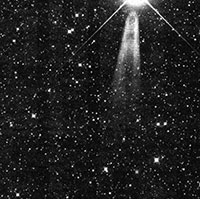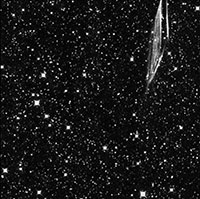


III. NEOWISE Single-exposure Images
III.2. Cautionary Notes
III.2.c. Image Anomalies and Features
III.2.c.i. Temporal Evolution of Glints: Comparing NEOWISE 2016 Data Release to All-Sky Data
To assess whether the character and intensity of bright star glints from single-exposure frames are changing with time, this section compares glint examples in the NEOWISE 2016 Data Release (hereafter, NEOWISE Year 2) to glints in the All-Sky
Data Release. This analysis also shows more fully than in previous descriptions (see glint flagging in ARTID in the All-Sky Explanatory Release Supplement, Sec. IV.4.g) how the glints vary as a function of the bright star's position just off the array. This section analyzes only those glints created by bright stars either just above or below the array, since the bright star responsible for the glint can be seen in the same scan as the glint itself.
Ideally, a perfect test of the stability or non-stability of glints over time would involve characterizing the glint for a single bright, non-variable star at many positions just outside the array. However, a star near the ecliptic is imaged only about two dozen times per year, meaning that we must use an ensemble of stars in order to conduct the analysis. Also ideally, we would like to restrict our analysis to a narrow range in brightness, but stars causing glints are typically the brightest ones (W1 < 2 mag) that are rare and whose photometry is the most poorly measured by WISE. Therefore, we select stars based on the more accurately measured bright magnitudes from 2MASS, and specifically use J < 2.0 mag. We also prefer to use stars with bluer J-Ks colors, and hence W1-W2 colors, so we can better gauge behavior across bands without having to take into account severe magnitude differences between the two bands, as would be the case for an extremely red Mira variable. For this, we stipulated that our bright star sample excludes extremely red sources (J-Ks < 0.9). To further ease analysis, we use only those bright stars more than 10 degrees outside of the Galactic Plane that fall in a frameset of pristine quality and that are free of contamination by moonlight and outside of the South Atlantic Anomaly. The SQL query for this in the IRSA catalog query is (abs(glat) > 10.) and (qual_frame = 10) and (saa_sep > 0.) and (moon_masked like '00__') and ((j_m_2mass - k_m_2mass) < 0.9) and (j_m_2mass < 2.0).
Because this bright star sample is still relatively small, we were not able to judge glint properties for all pixel positions. Instead, we have made a qualitative assessment of the glint properties for bright stars falling in ten different zones, as shown in Figure 1. Each zone is roughly 102 pixels wide (4.7 arcmin) in y and spans the entire range in x.
 |
| Figure 1 - Two consecutive frames of W1 data. In the upper frame, we show the locations of the 10 zones considered for the glint analysis. Bright stars in some of these zones create glints in the preceding or following frame (or both). In this case, the bright star in Zone 3 creates a glint (boxed in orange) in the following frame. Stars in some zones appear to produce no glints, although it should be noted that extremely bright stars—above magnitude zero—may produce glints in these zones that may not be adequately accounted for in our analysis due to the small number of such stars available. |
The following movies show the morphology and magnitude of the glints for bright stars in each zone where glints are produced. The frames in the movie are ordered by the x pixel position of the bright star on the preceding or following frame, so the associated glints are seen to traverse the image from left to right. Please click on the thumbnails below in order to run the movies.
Stars in Zone 5, Zone 8, and Zone 9 produce glints in the preceding frame. (Note that stars falling in Zone 10 appear on the preceding frame due to the ~10% overlap between frames, so there are no glints to consider.) Movies showing the glints in All-Sky and NEOWISE Year 2 are shown in Figures 2 through 13.
| Zone 5: Glints appear towards the bottom of the array but are seen only for the very brightest stars. |
 |
 |
 |
 |
| Figure 2 - W1 All-Sky glints produced in the preceding frame by a bright star in Zone 5. |
Figure 3 - W1 NEOWISE Yr2 glints produced in the preceding frame by a bright star in Zone 5. |
Figure 4 - W2 All-Sky glints produced in the preceding frame by a bright star in Zone 5. |
Figure 5 - W2 NEOWISE Yr2 glints produced in the preceding frame by a bright star in Zone 5. |
| Zone 8: Glints appear towards the bottom of the array and are far more prominent in W1 than in W2. |
 |
 |
 |
 |
| Figure 6 - W1 All-Sky glints produced in the preceding frame by a bright star in Zone 8. |
Figure 7 - W1 NEOWISE Yr2 glints produced in the preceding frame by a bright star in Zone 8. |
Figure 8 - W2 All-Sky glints produced in the preceding frame by a bright star in Zone 8. |
Figure 9 - W2 NEOWISE Yr2 glints produced in the preceding frame by a bright star in Zone 8. |
| Zone 9: Glints appear towards the bottom of the array and are far more prominent in W1 than in W2. |
 |
 |
 |
 |
| Figure 10 - W1 All-Sky glints produced in the preceding frame by a bright star in Zone 9. |
Figure 11 - W1 NEOWISE Yr2 glints produced in the preceding frame by a bright star in Zone 9. |
Figure 12 - W2 All-Sky glints produced in the preceding frame by a bright star in Zone 9. |
Figure 13 - W2 NEOWISE Yr2 glints produced in the preceding frame by a bright star in Zone 9. |
Stars in Zone 2, Zone 3, Zone 4, and Zone 5 produce glints in the following frame. (Note that stars falling in Zone 1 appear on the following frame due to the ~10% overlap between frames, so there are no glints to consider.) Movies showing the glints in All-Sky and NEOWISE Year 2 are shown in Figures 14 through 29.
| Zone 2: Glints appear towards the top of the array and are far more prominent in W1 than in W2. |
 |
 |
 |
 |
| Figure 14 - W1 All-Sky glints produced in the preceding frame by a bright star in Zone 2. |
Figure 15 - W1 NEOWISE Yr2 glints produced in the preceding frame by a bright star in Zone 2. |
Figure 16 - W2 All-Sky glints produced in the preceding frame by a bright star in Zone 2. |
Figure 17 - W2 NEOWISE Yr2 glints produced in the preceding frame by a bright star in Zone 2. |
| Zone 3: Glints appear towards the top of the array and are especially prominent in the upper right corner. |
 |
 |
 |
 |
| Figure 18 - W1 All-Sky glints produced in the preceding frame by a bright star in Zone 3. |
Figure 19 - W1 NEOWISE Yr2 glints produced in the preceding frame by a bright star in Zone 3. |
Figure 20 - W2 All-Sky glints produced in the preceding frame by a bright star in Zone 3. |
Figure 21 - W2 NEOWISE Yr2 glints produced in the preceding frame by a bright star in Zone 3. |
| Zone 4: Glints appear towards the top of the array and are far more prominent in W1 than in W2. |
 |
 |
 |
 |
| Figure 22 - W1 All-Sky glints produced in the preceding frame by a bright star in Zone 4. |
Figure 23 - W1 NEOWISE Yr2 glints produced in the preceding frame by a bright star in Zone 4. |
Figure 24 - W2 All-Sky glints produced in the preceding frame by a bright star in Zone 4. |
Figure 25 - W2 NEOWISE Yr2 glints produced in the preceding frame by a bright star in Zone 4. |
| Zone 5: Glints appear towards the top of the array and are most easily seen in the upper right corner. |
 |
 |
 |
 |
| Figure 26 - W1 All-Sky glints produced in the preceding frame by a bright star in Zone 5. |
Figure 27 - W1 NEOWISE Yr2 glints produced in the preceding frame by a bright star in Zone 5. |
Figure 28 - W2 All-Sky glints produced in the preceding frame by a bright star in Zone 5. |
Figure 29 - W2 NEOWISE Yr2 glints produced in the preceding frame by a bright star in Zone 5. |
These movies demonstrate that, while the glint pattern is largely unchanged between All-Sky and NEOWISE Year 2, the intensity of the glints is somewhat diminished in the later data.
Last update: 25 September 2024








